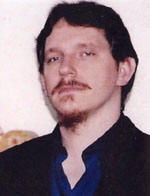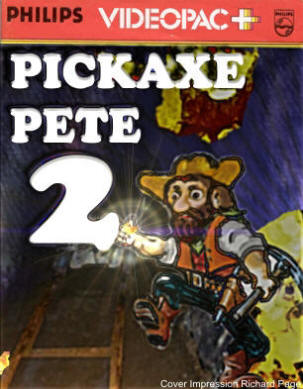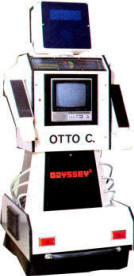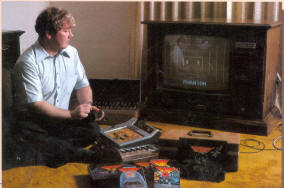

| NOBODY's FOOL (an interview with Ted Szczypiorski) | |
 q.
Ted you have become the most active and inovative programmer in the
O2/Videopac scene, is this something you set out to do ? q.
Ted you have become the most active and inovative programmer in the
O2/Videopac scene, is this something you set out to do ?No, actually. After Planet Lander, I wanted to write some games for a bunch of different systems that I had when I was a kid (oh, those 8-bit days), like the Vectrex, TS1000 (ZX81), Atari, and maybe Commodore PET and Colecovision. Once Planet Lander came out and I saw the reaction it got, especially from the Videopac folks overseas, I just had to write more games for it. Also, the O2 seemed neglected by homebrewers. At the time, only AMOK and KTAA existed. Any game written for it would be appreciated. You can also thank Soeren Gust, because without his instructional PDF, I never would have gotten into the homebrew scene at all. q. what was your first ever program (any machine) ? I'm sure my first program was on my Commodore PET. But, it was so long ago, I don't know what it was. Probably something simple like "Type your name" and it will display backwards. I think my first real game that used some machine language was on the Atari 800XL. You were a spaceship and you had to avoid the other moving ships. This was probably in the late 80's or early 90's. The Atari STs, Amigas, and Macs were out by then, so I was already programming for a retro system. q. where did you learn to program and when ? I'm self taught. I learned from books and COMPUTE! magazine. I started around 1980, when I was around 7. I only knew Basic for the longest time. I thought any one who knew machine language (ML) would have to be a genius. It wasn't until my late teens, looking thru an old Atari book that had a short machine language subroutine completely explained, that it started making sense. I then concentrated on writing ML. It was like the mysteries of the world finally being explained. I could finally write all those arcade games that I only dreamed about writing. If that's not geeky enough -- I didn't have a compiler. But, in one of my books there was a chart of all the commands and opcodes. I had to write DATA statements in basic with just the raw numbers. It was very tedious, but it did teach me exactly how a computer works. q. when you start writing your games, do you do sketches, designs or just start typing and see where it leads you ? I usually have an idea in my head and just start coding. There's usually a few different versions in the first few months, just to compare and see what works best. Since I'm not commissioned for these games, I can change my mind as to what things I want to keep or throw away. Sometimes, the ideas just don't work. In Mr. Roboto, the CPU vs. Robot screen went thru a few versions. Originally, the CPU player controlled the Firewalls (there wasn't a missile). It was too hard for a person to control the walls, though, and the Robot easily won. q. Mr Roboto's hidden challenge, are there other hidden features in your games such as planet lander, Puzzle peice panic or pick axe pete2 ? No. So far, Mr. Roboto is the only one. PAP2 is barely even started, so I don't know about that one, yet. q. do you have a release date on puzzle peice panic yet and will it be through Pakrat ? PPP will be released by Packrat. It should be available very soon. A surplus of carts is being made before it is released.  q. what new features do you hope to add to Pick axe pete2 Like I said, I just started it, so I don't know, yet. My goal is to make a side-scroller, since the O2 doesn't have one, yet. I think the hard part is going to make the scrolling look real. q. you're a web designer by day, homebrew programmer by night... apart from your guitar, what activities do you use for escape ? Music and computers are my escape. I've also started doing some hardware things, too. I've built a serial port for the keyboard of my Timex Sinclair, and I was tinkering with a light pen for the Odyssey2 a few months ago, but I had to stop and get back to finishing PPP. q. in other peoples homebrews, have you seen something that you have admired, some feature or trick ? Soeren did a good job of using the standard O2 gfx to make the different scenes in KTAA. Rene van den Enden showed me some gfx experiments that were interesting.
Not official cover but artist impression (well not even artist, mine ) q. do you collect games for any system
? TEDS WEBSITE
www.tedfoolery.com |
|
| The Truth Behind The Nightmare (www.videopac.org.exclusive) MARCH 2006 | |
  In
1982 UK G7000 owner and gamer Peter Courtney conceived an idea
for a new game, set in a haunted mansion, and believed it would be
entirely within the capabilities of his much loved Philips G7000, so
much so that he produced a game plan and design to submit to Steve
Newbold (Marketing Manager of Philips G7000 UK at the time). Steve liked
the idea, approved it and sent it further to the tech boffins in
Eindhoven, while sending this reply to Peter on the 6th of April 1982. In
1982 UK G7000 owner and gamer Peter Courtney conceived an idea
for a new game, set in a haunted mansion, and believed it would be
entirely within the capabilities of his much loved Philips G7000, so
much so that he produced a game plan and design to submit to Steve
Newbold (Marketing Manager of Philips G7000 UK at the time). Steve liked
the idea, approved it and sent it further to the tech boffins in
Eindhoven, while sending this reply to Peter on the 6th of April 1982.
In peters own words "Some months later Nightmare was released - which was my game design". Peter had received no acknowledgement at all from Philips for the game design either personally or in the game packaging.
So if they already had this game in development, why did Christer Medin Manager of the software development team in 1983 not know this when he sent the second letter to Peter. I personally feel that had peter gained copyright on the game concept prior to sending it to Philips then he would have received his much deserved acknowledgement and indeed even some royalties. So on behalf of the Videopac games of the world :- Acknowledgement: Nightmare for the G7000 Conceived by Peter Courtney (UK)
|
|
|
The Videopac Piracy Scandal of 1982 taken from sorely missed www.videopac.com in 1998 |
|
|
In November 1996 an
interesting little piece of Videopac history was uncovered. A local
collector offered Dutch Videopac enthusiast Marco Kerstens a set of
Videopac chips he found at a flea market. It turned out to be an almost
complete collection of Videopac games on EPROMs. There were almost 100
EPROMs and three home made EPROM holders: ZIF sockets soldered onto
rewired, regular Videopac carts. Most EPROMs contain one game, but there
are also 15 EPROMs that have two games on them. Hardware switches are
used to choose between the games. Around 75% of the EPROMs appeared to
still be working, the rest had gone bad in some way. Two of these games were made
by a company called GST-Video. This name is also present in some of the
Videopac Plus games, such as Super Bee, Norseman, and Blobbers. At this
time it is unknown how this name was related to Philips. One of the GST-games
has a title-screen, which shows the name 'Jake.
Two more, 'new' games were found in the set of EPROMS. The first is listed as 'Laser', but it turns out this probably is not the right name of the game. About a year after the find of the EPROMs two more remarkable finds were reported. One concerns the find of a Videopac multi cart, or game switching device. In this device a PROM was found labelled 'Robot City' . The game turned out to be 'Laser'. The same name, Robot City, also turned up in the second find, by Rikard Ljunkvist, of what may be a real prototype. The second new game is listed as a 'catch game' (again, no actual title is known). So, all in all, four games were discovered that had not been known to the Videopac collectors community before. Follow the links in this text or the links below to learn more about the gameplay and view some screenshots. At this point, it should be pointed out that the games are quite good, so be sure to read the reviews! With the very kind help of
Markus Gietzen and Dan Boris the games have been rescued from possible
decay. ROM dumps have been made, which can be used for multicarts and
emulators. Hopefully you will soon be able to enjoy these games.
|
|
| And then there was lights | |
|
This building known as the white lady (picture left) was the original research and development department for Philips once its was successfully established as a world leader in lighting technology. Philips is now a multinational with branding recognised throughout the world employing people in England, France & The United States In the 1920s Philips moved into x-ray and radio technology and were instrumental in the development of television as early as 1925 due to its relationship with the cathode ray tube. In 1960s Philips developed transistors and integrated circuits to replace its valve tube technology which was instrumental in establishing Philips and a groundbreaking electronic component developer this resulted in important discoveries such as CCDs (charge-coupled devices) and LOCOS (local oxidation of silicon). In 1974 Philips obtained the US company Magnavox which had been the company behind the release of the worlds first TV game system, Ralph Baers Brown box, which was released in 1972. Magnavox released the Brown box under the name of the Odyssey. more information here although Baer had been developing a device that could use a television screen as an interactive games device since 1967. After a few further developments and advancements
to compete with the likes of Atari such as the odyssey100 a major leap
came in 1978 with the odyssey2. However the original odyssey 2 console was never released as it had been developed with 24 built in games, but the major competitors for the home games market ATARI had just released the Atari VCS (2600) which allowed interchangeable games on ROM. The Magnavox design was changed to accommodate this and so the console released in Europe as the Philips G7000 or in France as the C52 is now also known as the Magnavox Odyssey2. |
|
| Where's Otto ? | |
 The Odyssey Robot in 1982 The worlds fair in Knoxville, Tennessee the Magnavox stand was showing the latest Odyssey hardware and games, specially made for the event was Otto The robot, who later went on visiting Hospitals and schools with Jim Cofield & Mearl Eakins an odyssey sales manager. October 1982 is my last record of Otto, according to the summer 1983 edition of Odyssey adventure, Otto visited Pickerington Ohio, and promised to continue his journeys around the USofA. Can you place Otto after this, does he still exist.... does he have a brother or two ? What does the C in "Otto C." stand for ? admin@videopac.org please
|
|
| On the subject of where are they now... | |
 While looking through Odyssey Adventure I spotted something in this picture that I hadn't seen advertised as an accessories (vol1 issue 2) spring 1982, and that would be these rather nice brown Videopac carry cases. The odyssey adventurer magazine, was the O2's equivalent of the G7000 club newsletter, and baring in mind that the Videopac had those white carry cases, it stands to reason that the US would have their own versions. The OA magazine is a useful resource of various
accessories for the O2 and as the issues progressed you were able to order lots
of nice accessories from the mag such as the clear plastic o2 & cart organiser,
pictured in the first pic' as well as covers, Frisbees, scorecards, badges, plush
toys & tee-shirts, but even there these carry cases are not mentioned other
than this picture.. looking at t opinions in the forums please. or admin@videopac.org (is he playing quest for the rings alone ?)
|
|